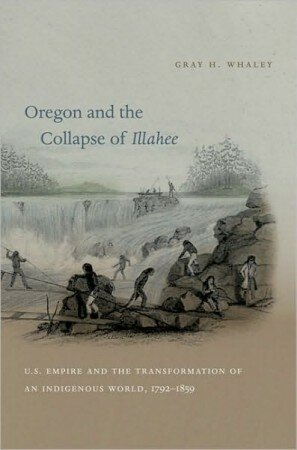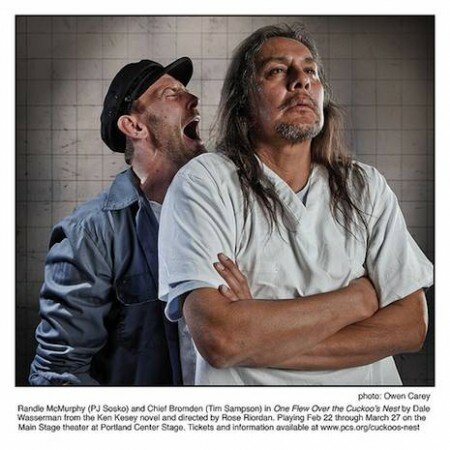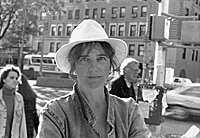Gray H. Whaley’s brand new guide to the first five decades of European American presence in Oregon uses the Chinook concept of “Illahee” (homeland) as a counterbalance to the American concept of “Oregon”, the idea of an empty, fertile wilderness bequeathed directly to settlers by God. The title of the book, Oregon and the Collapse of Illahee: U.S. Empire and the Transformation of an Indigenous World, 1792-1859, uses words which imply the erasure of Native American culture: “collapse” and “transformation”.
However, in real life, in the Oregon I live in, erasure is not the right word for what happened to the First Oregonians.
Testimony to that could be seen on stage and screen last month.
Matt McCormick originally imagined Carrie Brownstein in the role he eventually gave Renee Roman Nose in Some Days Are Better Than Others. Roman Nose plays a woman who in the course of her work sorting donations to Goodwill discovers a funeral urn filled with the remains of a human being. McCormick didn’t write his screenplay with the goal of balancing his tiny cast racially, it just happened in the casting.
Umatilla musician and music historian Thomas Morning Owl, Jr co-wrote the stage musical The Ghosts Of Celilo with Marv Ross over a period of ten years. The Ghosts of Celilio is based on true events which occurred when The Dalles dam inundated a ten thousand year old fishing village in 1957. Morning Owl Jr has appeared in both Portland productions of The Ghosts Of Celilo, playing the heavy.
The ghosts of Celilo also haunt Chief Bromden, the character played by Tim Sampson in Portland Center Stage’s production of Dale Wasserman’s adaptation of One Flew Over The Cuckoo’s Nest. Sampson is the son of Will Sampson, the actor who made his debut playing the same role in Milos Forman’s 1975 film. Wasserman’s stage treatment preserves the centrality Ken Kesey’s novel assigned to Bromden, a bi-racial, self elected mute whose stream of consciousness narrates the action.
In Meek’s Cutoff, Rod Rondeaux plays the Cayuse Indian who crosses paths with a hopelessly lost, and perilously thirsty, wagon train. Screenwriter Jon Raymond based his script on an actual event, recorded in an 1845 pioneer diary.
All four stories – Meek’s Cutoff, Some Days Are Better Than Others, One Flew Over The Cuckoo’s Nest, and The Ghosts Of Celilo – seamlessly incorporate European American and Native American characters. Meek’s Cutoff and The Ghosts Of Celilo were based on historic events; Some Days and Cuckoo’s Nest based on imagined ones.
Whether the events were real or imagined, all five Oregon writers – Jon Raymond, Matt McCormick, Ken Kesey, Thomas Morning Owl, Jr. and Marv Ross – tell stories set in biracial worlds because that choice most faithfully reflects the world in which they live.
When did Oregon writers start exploring the bi-culturality of our state ?
1873: Joaquin Miller writes Life Amongst The Modocs: An Unwritten History
1883: Sarah Winnemucca writes Life Among The Piutes: Their Wrongs and Claims
1890: Frederick Homer Balch writes The Bridge of the Gods: A Romance of Indian Oregon
1902: Eva Emery Dye writes The Conquest: The True Story of Lewis and Clark, with Sacajawea at the center of her narrative
1940: Yellow Wolf dictates Yellow Wolf: His Own Story to Lucullus Virgil McWhorter
1960: Don Berry writes Trask
1962: Ken Kesey writes One Flew Over The Cuckoo’s Nest
1983: Ron Finne makes Tamanawis Illahee: Rituals and Acts In A Landscape
1987: William Kittredge writes Owning It All
1993: Elizabeth Woody writes Seven Hands, Seven Hearts
1995: Craig Lesley writes Winterkill
1998: Chris Eyre makes Smoke Signals
2000 Marv Ross and Thomas Morning Owl, Jr begin writing & composing The Ghosts Of Celilo
2010: Matt McCormick makes Some Days Are Better Than Others
2010: Jon Raymond writes Meek’s Cutoff
In Meek’s Cutoff, the wagon train has to decide whether they want to kill the one human being they have found in the desert or entrust their lives to him. Oregon literature has been grappling with the repercussions of that decision ever since.
Two of these four stories deal with the damming of Celilo Falls, an event which is evoked on the front of Whaley’s new book. So maybe we add Whaley as the fifth story teller.
(Ed note: Whaley says the engraving on the cover of his book is of Willamette Falls, in Oregon City).
The above book list is not comprehensive! I am not covering all related works of art, nor all artists. Please feel free to add names/titles I have omitted.
For people who would like to know more about the books on the list — several are on Walt Curtis Recommends: Top Nine For Oregon Bookworms. Another great list can be found on the Oregon Cultural Heritage Commission website.







3 responses so far ↓
1 Tamanawis Illahee: Rituals And Acts In A Landscape (1983)/Lost film | Oregon Movies, A to Z // Mar 28, 2012 at 8:31 am
[...] Tamanawis Illahee is a perfect demonstration of Oregon’s deep, unacknowledged biculturality. [...]
2 Gray H Whaley // Jun 11, 2012 at 10:05 am
Dear Anne, Please don’t judge a book by its cover. If you ever read it, I think you will probably find the title, image, and text less distasteful. P.S. That’s the Willamette Falls.
Cheers, Gray
3 Anne Richardson // Jun 12, 2012 at 12:18 am
Hi Gray,
I am not against your book. I don’t think Oregon can accurately be described as a post-Illahee landscape, for the reasons I give. I have nothing against your book. I certainly don’t find it distasteful. Thank you for clarifying that those are the Willamette Falls.
AR
Leave a Comment